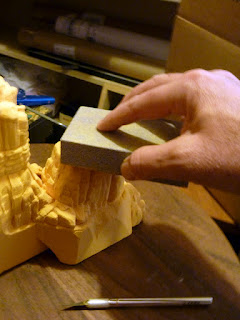 |
| Baxter's Butte. © Disney |
Way out in the wild canyon lands of the Southwest, beyond the Rainbow Desert on the old stage line to Grizzly Flats, you'll find Thunder Mesa. Indian legend claims that the twisted rock spires in the area are really people turned to stone by an angry thunder god, but most folks pay little heed to such tall tales. Fact is, nobody much came that way until an old prospector called Badwater Baxter found gold on the Mesa back in the '60s. His claim didn't stay a secret very long and soon the rush was on! People came from all over to seek their fortune and a town seemed to spring up from the wilderness overnight. They called it Thunder Mesa, the biggest little boomtown in the West.
 |
| The Biggest Little Boomtown in the West. © Disney |
As the mining operation grew it became clear that a railroad would be needed to haul the rich ore to market. Investors from the Santa Fe, Denver & Carolwood Railroad (SFD&C) agreed to build a branch line to the boomtown of Thunder Mesa and operate a narrow gauge mining railway to the mining districts beyond. Construction proved long and difficult due to the extremely rugged terrain but the Grizzly Flats branch of the SFD & C finally reached Thunder Mesa in the summer of '79. From there, the new Thunder Mesa Mining Co. Railway wound its way through the labyrinth of canyons to the rich diggings around Calico Mt.
Soon, the fame of the little railroad spread far and wide and special excursion trains had to be added to the schedule for visitors demanding to see the unmatched scenic wonders that the railway passed through. While tunneling through Rainbow Ridge, for example, railroad construction crews discovered amazing caverns filled with colorful formations and waterfalls.
 |
| Rainbow Caverns. © Disney |
Elsewhere along the line fantastical red rock hoodoos towered and teetered over the tracks and geothermal features bubbled and boiled below the new Geyser Gulch trestle. Abundant wildlife was everywhere and before long the whole area became known as a veritable Nature's Wonderland.
The Model Railroad
This is my third attempt to build a model railroad along this theme. The first was in HO scale and didn't get too far:
 |
| The First Big Thunder & Western. |
That model grew into a much more elaborate On30 railroad that expanded the theme with a branch line up to a version of Knott's Berry Farm's Calico Mine:
 |
The On30 BT&W
|
 |
| About as far as it got. |
As an artist, I also really got a kick out of creating some fun graphics for the fictitious railroad:
But the most fun was planning animations and special effects like the Pepper's Ghost rainbow effect deep inside Rainbow Caverns:
 |
| Rainbow Caverns on the BT&W. |
 |
Engine #9, the Davy Crockett emerges from a tunnel.
The scenery is carved and painted polystyrene foam. |
Unfortunately, this version of the BT&W did not survive a move and certain life complexities. However, I hope to recreate some of these effects on the new railroad.
Starting Over, Starting Small
This time around I'm not being quite so ambitious. For one thing, I don't have the space. The railroad I'm building now is just 3x6'. It's an island type design with just a single loop of track and a couple of sidings. There are plans for possible expansion but we'll keep those under wraps for now. Here are some construction photos of the railroad to date, plus a color rendering of the direction things are headed:
 |
| Basic benchwork. |
 |
| A start on the scenery. |
 |
| Big Thunder Creek starts to take shape. |
 |
| Lots of pink foam! The area on the left is where a trestle will cross Geyser Gulch. |
 |
| Roughed in natural arch and future engine facility. |
 |
| Fun with Photoshop. |
The railroad will operate with Digital Command Control (DCC) and sound. Primary motive power will come from a pair of Bachmann Porters, redressed to resemble Disney's Big Thunder locomotives.
 |
| Big Thunder at WDW Magic Kingdom. © Disney |
 |
My version. The two locomotives will be named for
Disney animation legends Frank Thomas and Ollie Johnston. |
Things are progressing smoothly so far, with track laying, bridge construction and a solid base for the scenery well underway. This is a spare time "Sunday project" and I'm really in no hurry. If this type of project interests you, subscribe or check back monthly for updates. You can also follow along and join in the conversation on the Disney Railroads discussion board over at
Burnsland.com. Some fantastic modelers and real life railroad expertise over there, well worth checking out. Hope you'll come along for the ride!








































